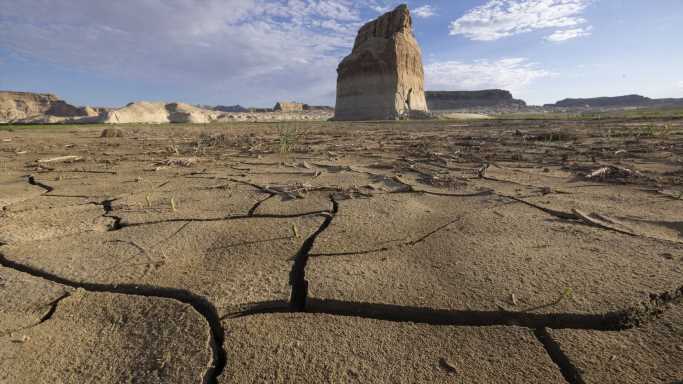Cracked mud dries in the sun where Lake Powell used to surround Lone Rock, in the distance, near Page, Arizona, in September. Photo: David McNew/Getty Images
U.S. officials released a set of proposals Tuesday for distributing cuts from the Colorado River — including one that would break from precedent by evenly assigning reductions among lower basin states, forcing users in California to shoulder more of the load.
Driving the news: The proposals would amend 2007 guidelines that govern cuts in the event of a shortage as climate change and other factors threaten the river, which that provides drinking water to 40 million people in seven states and 30 tribal nations.
- The U.S. Bureau of Reclamation released a draft supplemental environmental impact statement to potentially revise operations at the Hoover and Glen Canyon dams. Those dams created Lakes Mead and Powell — key reservoirs for the drought-stricken Colorado River.
- The bureau's proposals would govern releases from the two dams starting in 2024.
The big picture: The Colorado River basin is in the midst of a 23-year droughtthat ranks as the region's worst in 1,200 years.
- The drought has already triggered cuts to CAP's water allocation.
- The cuts could also impact tourism in popular travel destinations like Las Vegas and Los Angeles — Las Vegas gets 90% of its water from Colorado River, per CNN.
Threat level: The river has in recent years faced threats including rising temperatures, increasing droughts and outdated river management.
- Experts say the river's flow is expected to fall 10-30% by 2050 due to climate change.
Details: That statement includes three options for apportioning cuts that would save nearly 2.1 million acre-feet of water, including previously agreed-to cuts, which would be more than 15% of the river's total flow.
- In addition to previously established cutbacks, the proposals would reduce river use by 500,000-600,000 acre-feet, Sarah Porter, director of the Kyl Center for Water Policy at Arizona State University's Morrison Institute for Public policy, told Axios.
- The first proposal would allocate cuts based on legal priority of water rights, which governed previous cuts, favoring California. It's similar to a proposal the state crafted.
- The second would evenly distribute cuts among lower basin states of Arizona, California and Nevada, much like a plan proposed earlier this year.
The bottom line: The other option is to do nothing, which would threaten Lake Mead and Lake Powell with "dead pool" conditions in which water levels would be too low for the dams to function.
Zoom in: Users in California have some of the highest-priority water rights from the river, which would largely protect water users from cuts.
- The Central Arizona Project (CAP), which pipes river water to the interior of the state, has the lowest-priority rights under the 1968 federal legislation that authorized its construction.
Of note: The upper basin states of Colorado, New Mexico, Utah and Wyoming wouldn't lose additional water under the bureau's proposals.
What they're saying: "[B]urdens associated with managing risks on the Colorado River must be shared across all sectors and by all water users," Central Arizona Project general manager Brenda Burman and Arizona Department of Water Resources director Tom Buschatzke said in a public statement.
- Arizona U.S. Sen. Kyrsten Sinema said Arizona can't bear the brunt of the cuts and the "only real, lasting solution is a consensus agreement between all Basin States."
- Colorado U.S. Sen. Michael Bennet called the proposal “a constructive step toward sustaining the Colorado River system for the long term” but also expressed urgency that all Basin states “come to an agreement.”
The intrigue: Porter noted the basin states could still reach an agreement independently.
- The federal proposals "should be an incentive to senior water users to think more flexibly … about what they could do," she said, adding it should be a message to junior priority users that they could bear the brunt of up to 600,000 acre-feet in additional cuts.
Of note: The upper basin states of Colorado, New Mexico, Utah and Wyoming wouldn't lose additional water under the bureau's proposals.
What's next: The public has 45 days to submit comments on the proposals to the bureau.
- The bureau will issue a final SEIS this summer and expects to make a decision about cuts in August.
- Whatever policy the bureau and Interior choose will be in place until the 2007 guidelines expire in 2026.
Editor's note: This article has been updated with further context.
Source: Read Full Article
-
‘She’s swung the pendulum in favour for Indyref2!’ Truss slammed for Sturgeon comments
-
Starmer is trying to ‘fix’ general elections to keep Tories out of power
-
Tory leadership: Liz Truss vows to cut VAT on energy bills if she becomes Prime Minister
-
Tories heading for chaos – Boris backers trigger rules to push for leader race SUSPENSION
-
‘You sat there when Labour BROKE law!’ Starmer given huge public dressing down in Commons


